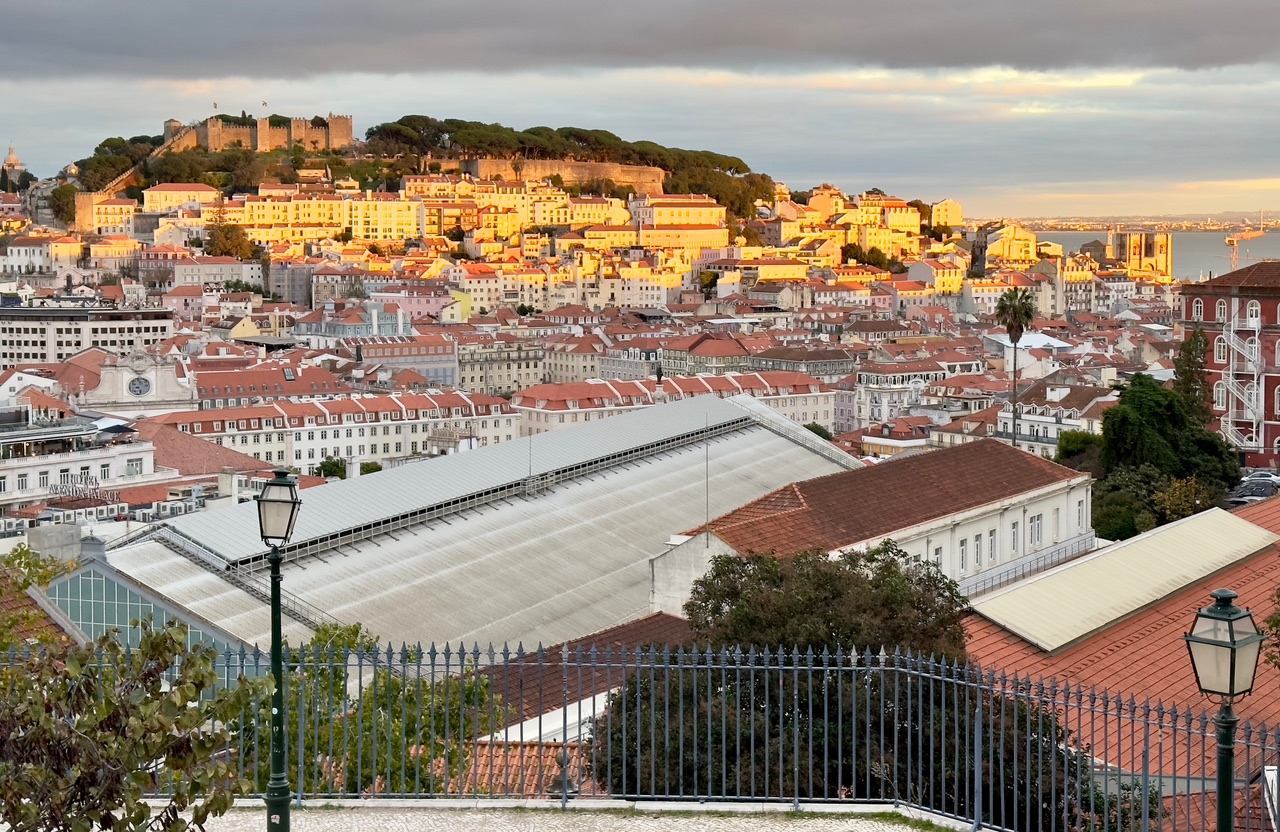Solo Travel In Lisbon – Your Ultimate Guide
Advice for visiting Lisbon from a seasoned solo traveler
As someone who has visited Lisbon several times as a solo traveler and loves the city, I hope you enjoy my ultimate guide for solo travel in Lisbon. If you are looking for an interesting place for your first or hundredth solo travel, Lisbon should be high on your list. The many reasons include great food, friendly people, interesting sights, and the ease of moving around the city.
Lisbon has become my favorite city in which to spend time. I have rarely felt alone and have enjoyed exploring this beautiful, diverse culture. Most days include a fun activity, strolling the lively, tile-covered streets, and indulging in a fabulous meal while listening to musicians on a tree-shaded patio.
Although there are plenty of sights to fill your day, I recommend leaving a chunk of downtime each day to enjoy the lovely weather while meandering through a neighborhood and relaxing at one of many small parks.
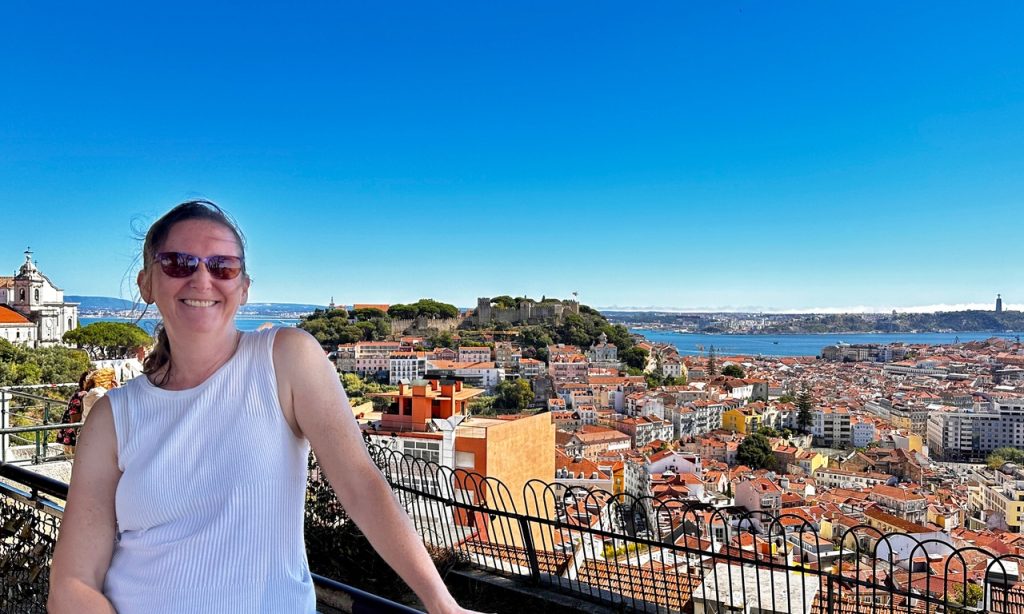
What To Do In Lisbon for Solo Travel
While I have appreciated visiting the Louvre Museum and the Colosseum, I love Lisbon’s smaller museums and sights. These activities are enchanting and allow time to enjoy more of the city.
Castelo de Sao Jorge (Castle of Saint George)
The history of the Castelo de Sao Jorge remains a bit murky, but the Romans and Muslims occupied this high point in the city centuries ago. The kings of Portugal in the 13th century mainly built the Gothic castle with ten turrets that we can tour today.
Walking along the tops of the walls provides some of my favorite views of Lisbon. You can ponder over the Tagus River, the 25th de Abril Bridge, the terra cotta roofs, and patches of green within the city.
Bonus Tip: Buy tickets online before your visit and go early in the morning to avoid long lines.
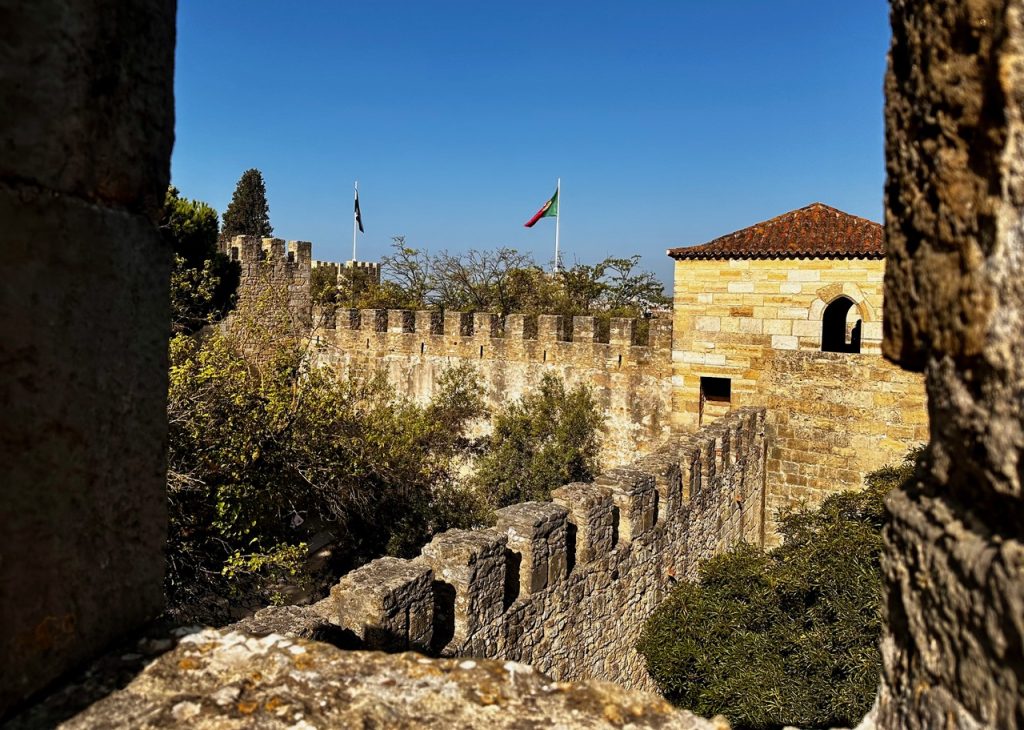
National Tile Museum
While wandering through Lisbon, visitors can see tiles, or azulejos, adorning most surfaces. Portuguese people started creating simple geometric patterns in the 13th century and over time adapted Hispanic-Moorish techniques that have dominated throughout the years since.
At the Museu Nacional Azulejo, you can learn more about the history of tile while viewing samples from long ago and today. A gold-gilded chapel,lovely interior two-story courtyard, and tranquil patio for snacking await.
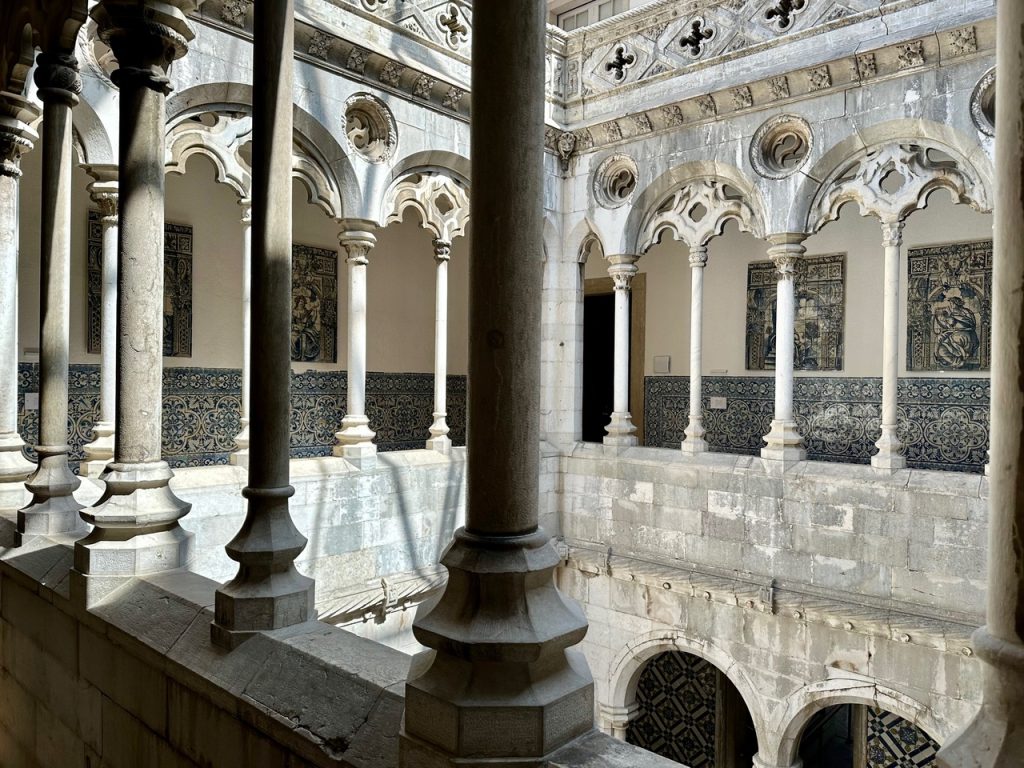
Calouste Gulbenkian Museum
In the early 1900s, Calouste Gulbenkian amassed a collection of over 6,000 pieces of art, from ancient to contemporary and from around the world. The Calouste Gulbenkian Museum was built in Lisbon to bring this treasure together for display.
The museum will be closed for renovation until July 2026, but the incredible garden and newly renovated Center for Modern Art are open and worth a visit. Traveling there by subway brings you within a few blocks of the complex.
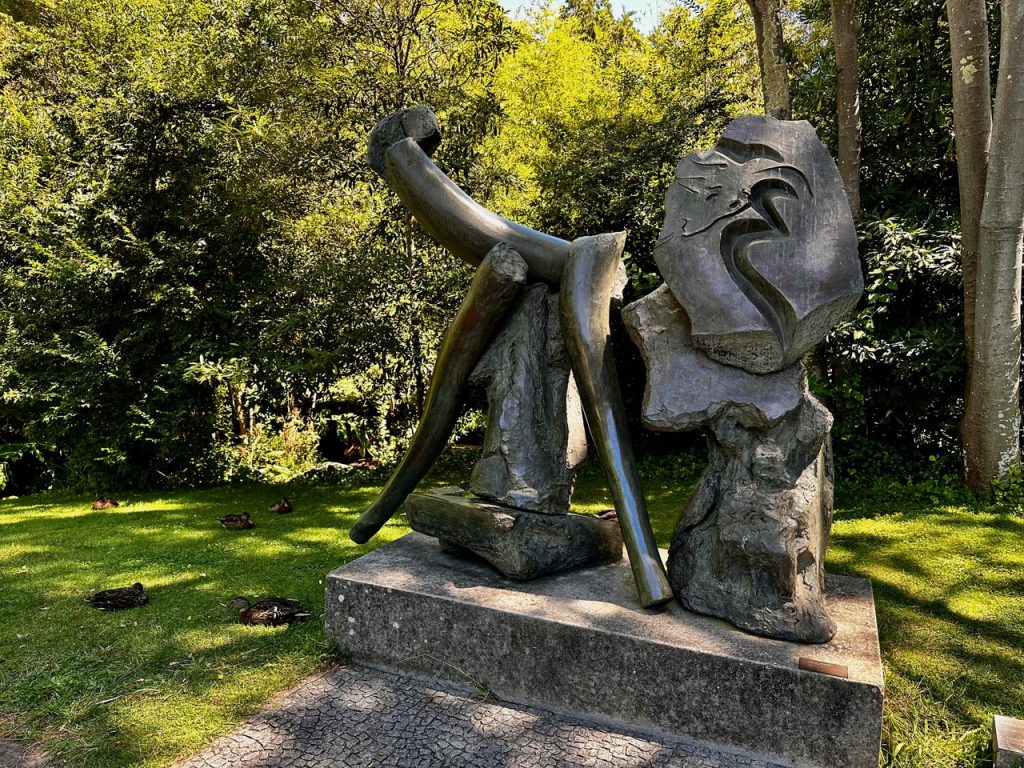
Roman Theater
In the first century AD, as a symbol of their vast empire, the Romans built a 4000-seat theater into the side of a hill overlooking the Tagus River. Today, sections of the ruins can be visited at the Museu de Lisbon.
The interior section of the museum displays architectural elements and various Roman artifacts. A walkway passes through a section of the walls and stairway of the theater. Across the street, a dig site reveals the rows of theater seats and the entranceway.
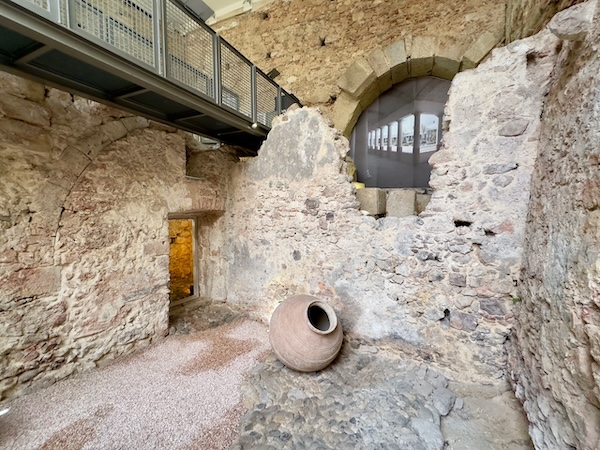
National Pantheon
The Portuguese Baroque architecture of the National Pantheon impresses visitors, from the multi-hued geometric patterns of the marble floors to the soaring domes. Your perspective of the interior changes with each level that you ascend to the rooftop views of Lisbon.

Feira da Ladra (Flea Market)
Next to the Pantheon, the Feira da Ladra sprawls across a few streets and offers all sorts of clothing, housewares, arts, and souvenirs. Small shops and an indoor market offer arts and crafts, including my favorite place to buy ceramic pottery on Campo de Santa Clara.
The market is easy to reach from the Santa Apolonia Blue Line subway station, although I often prefer to wind through the neighborhoods across Lisbon on foot.
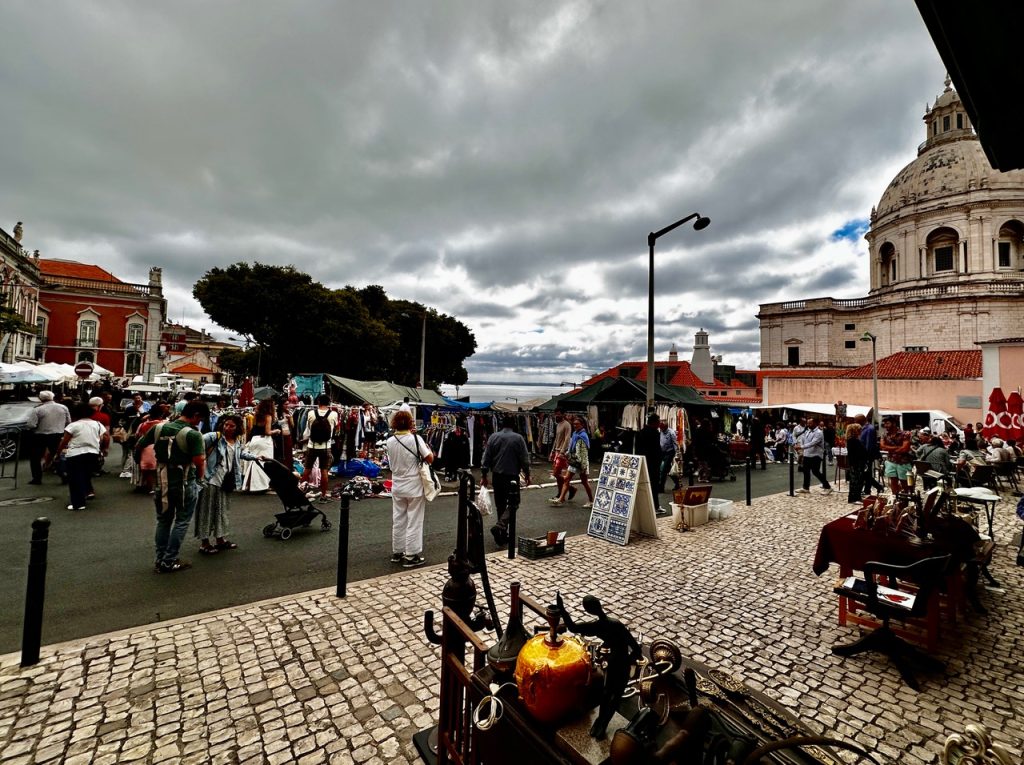
Churches in Lisbon Worth Visiting
Lisbon Cathedral
The oldest church in Lisbon, the Se (Cathedral), was begun in 1147 with additions and restorations over the centuries. Its Romanesque architecture is immense and dramatic, with a fantastic rose window and soaring cement columns.
From the high choir, the Cathedral’s eagle-eye view of the long, arched nave takes you back in time to the Middle Ages. Next to the choir loft, the Treasury gives an up-close look at religious relics and reliquaries, and a glimpse of the meeting room.
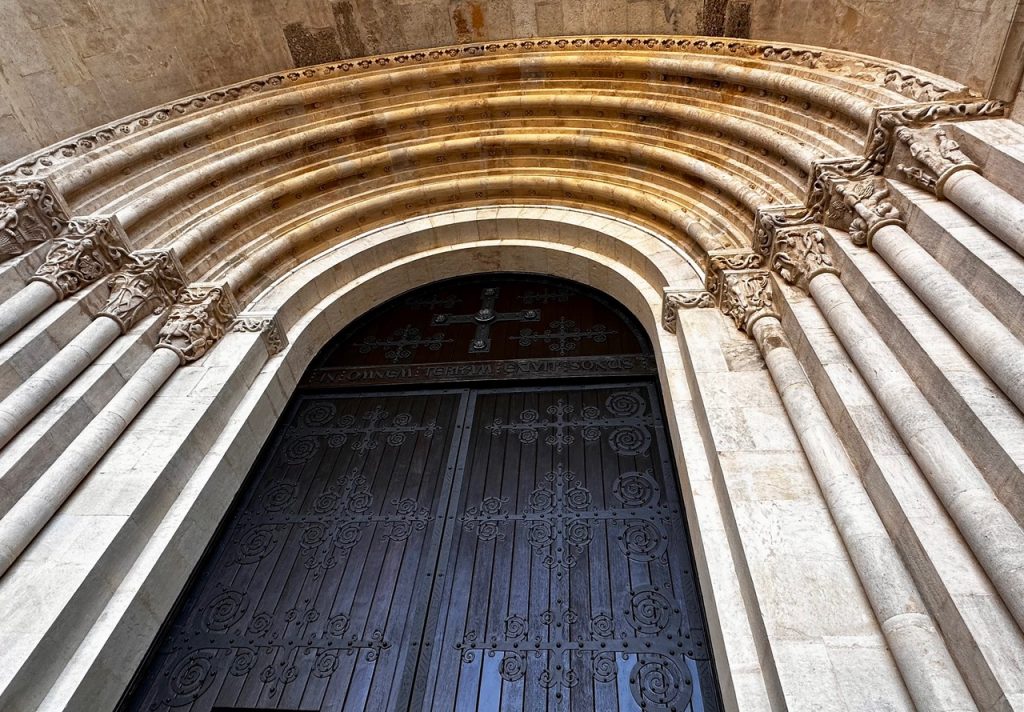
Saint Vincent de Fora
At the cloisters of Saint Vincent de Fora near the National Pantheon, over 100,000 glazed tiles adorn the walls with blue and white elaborately framed landscapes and scenes of daily life. The azulejos along the halls and stairways lead to an excellent panoramic view of Lisbon from the roof.
Don’t miss the tombs of the last Portuguese royal family which were moved to the monastery’s refectory in the mid-19th century by King Fernando II. A haunting statue mourns over the tombs of King Carlos and his son Luis Filipe, who were murdered to end their reign in 1908.
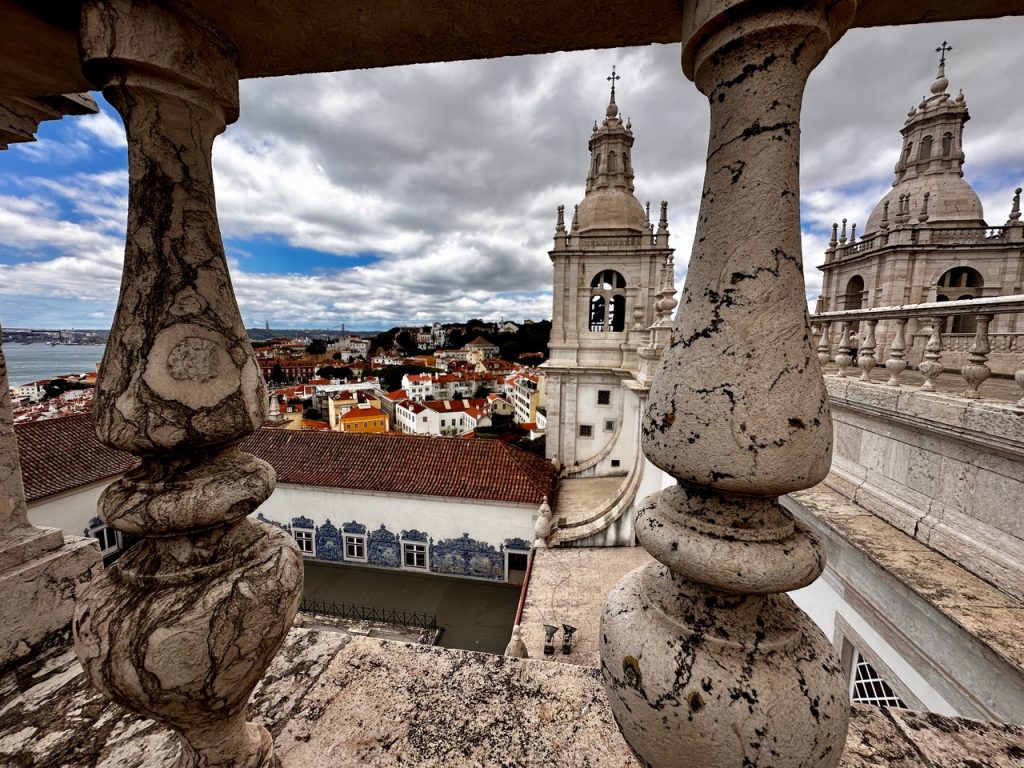
Saint Roch
I had walked past the Church of Saint Roch in the Barrio Alto several times without entering until a friend recommended it. In contrast to the simple façade, the interior is an almost shocking explosion of elaborately ornate gold, marble, and tile. The plaza out front hosts a small market and a monument to the historic lottery ticket sellers.

Basilica da Estrela
The neoclassical architecture and the dome resting above tall, curved windows alone would be worth a visit to the Basilica da Estrela. However, an elaborate nativity scene and rooftop terrace make this a must-see church.
I readily paid the small fee and was directed to a door near the altar, where an attendant let me into the nativity room. Then, I climbed up to the roof, where a light drizzle couldn’t distract from the incredible view. The park across Praca da Estrela has old trees with intertwining trunks and is a good respite of nature in this area of town.

Fado Music
Visitors to Lisbon can hear the traditional music of Fado at many locations around the city. Lisboa em Fado, in the Chiado neighborhood, provides an excellent overview of the history and importance of the native Portuguese music in nightly performances. I enjoyed hearing the guitars and singers perform various songs, from sorrowful to uplifting. They also offer a port tasting after the show.
You can also find Fado music at many restaurants, especially in the Barrio Alto and Alfama neighborhoods. From my experience, the musicians and singers entertain for brief periods with many breaks in between. The music is an entertaining accompaniment to dinner.
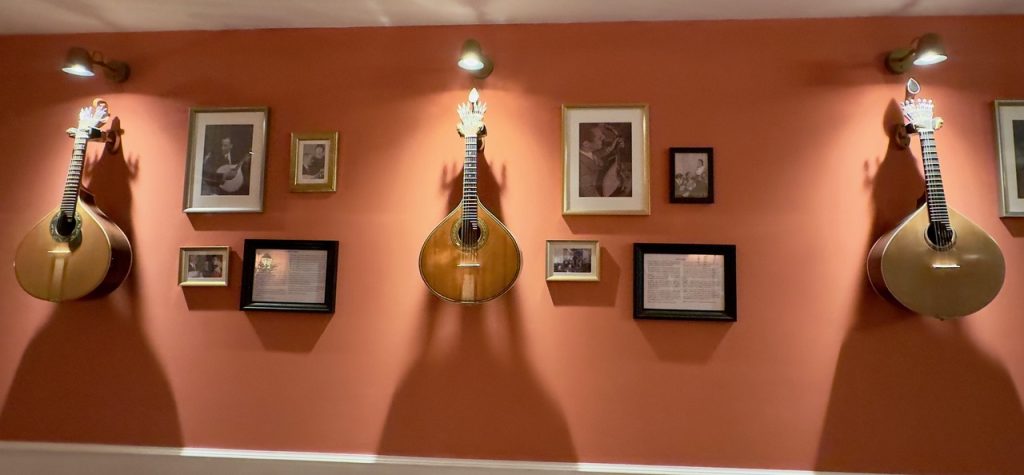
Easy Day Trips To Belem And Sintra for Solo Travel
When visiting Lisbon for a few days or more, a day trip to Belem or Sintra provides a plethora of incredible sights to enjoy. Taking a train is simple and inexpensive or you can use a ride-sharing app.
Belem
While Belem is a district of Lisbon, it is outside the central area and feels like a separate town. Multiple sights and museums within walking distance of each other provide a host of options to enjoy your day. I usually ride the train from Cais do Sodra, but you can also catch Tram No. 15 which travels along the river.
At the Museum of Art, Architecture, and Technology (MAAT), you can explore the Tejo Power Station which was built in the early 1900s and was Portugal’s largest power plant until 1950. Then, move to an elegant modern building housing displays of intriguing contemporary art.
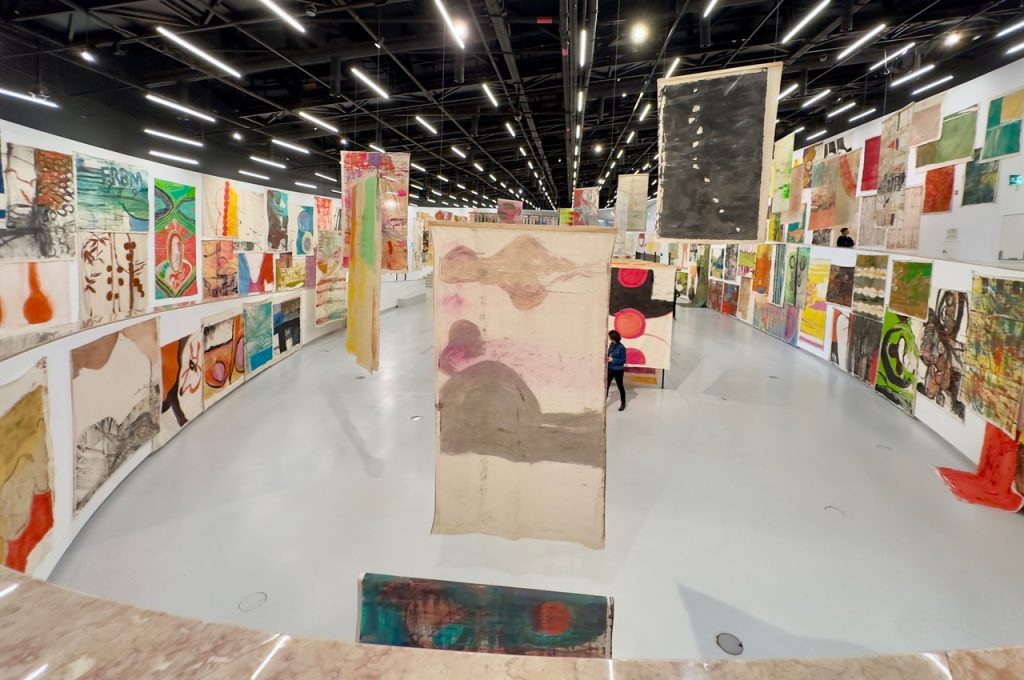
The Jeronimos Monastery, commissioned by King Manuel I in the late 15th century, contains an incredible cloister with ornate Manueline architecture.
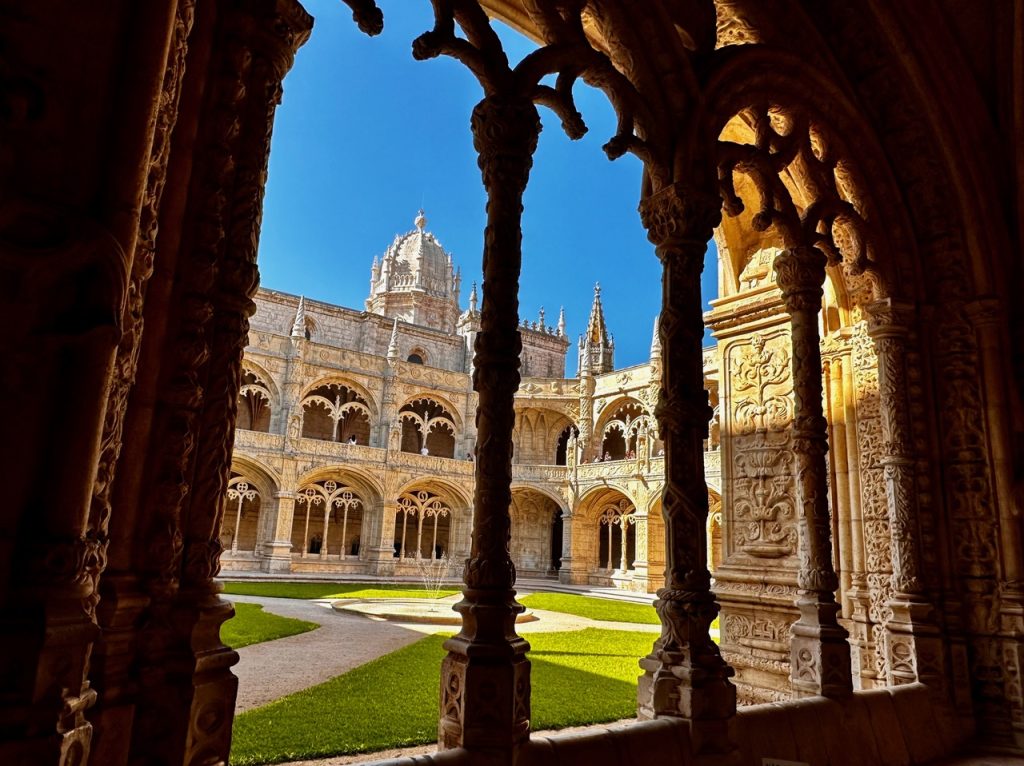
King Manuel also began the construction of the Belem Tower on the bank of the Tagus River to protect the monastery. You can buy a ticket to tour the tower and ascend to the terrace.

When I visited Belem, a long line snaked from the tower, so I elected to visit the viewpoint atop the Monument of the Discoveries instead. An elevator brings you to an excellent view of Belem and Lisbon.

The Maritime Museum showcases Portugal’s illustrious history of exploring the world. You can walk amid full-sized royal barges and whaling boats in an airplane hangar. There is also an aquarium and planetarium in the complex.
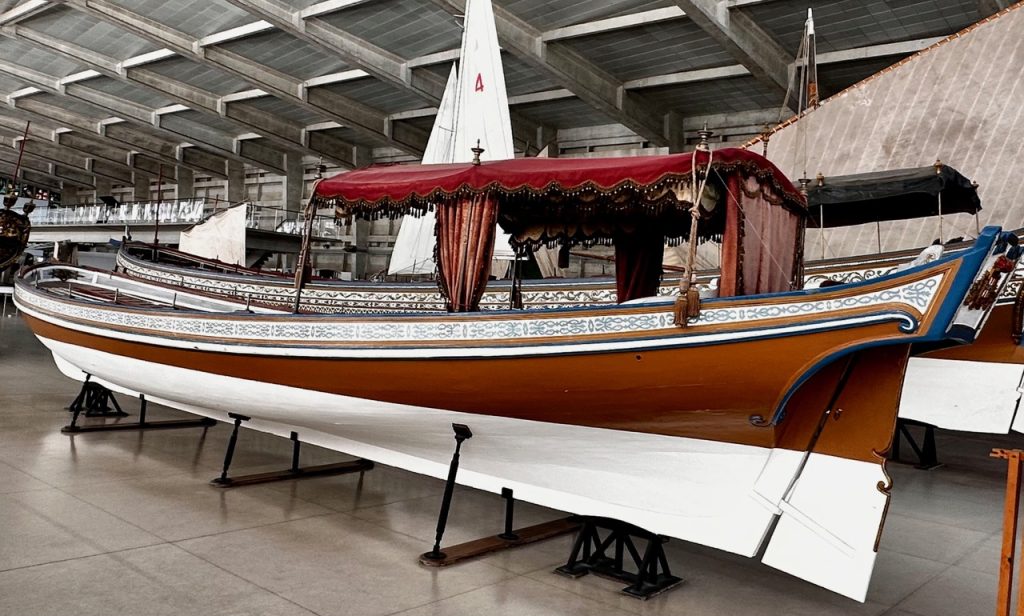
Another fascinating historical insight is at the National Coach Museum, containing vehicles from the 17th, 18th, and 19th centuries. Carriages range from elaborate royal ones decked out with gold statues to simple utilitarian coaches. The Old Royal Riding School across Rua de Belem is also worth a visit.

The Quake Museum offers an interactive experience, allowing visitors to experience the 1755 earthquake that devastated Lisbon.
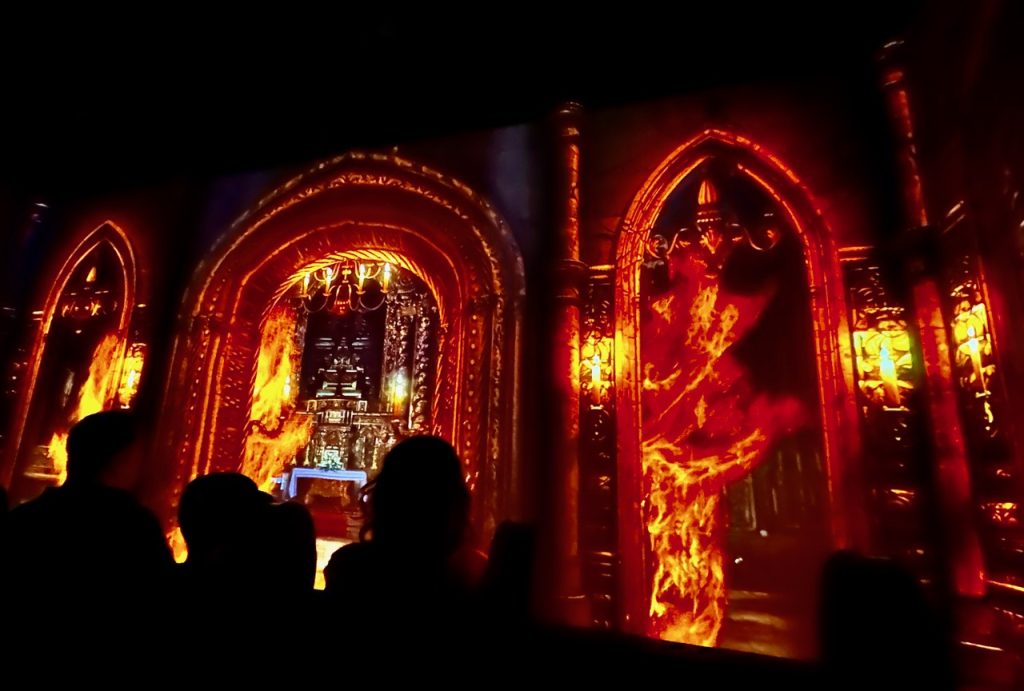
The Tropical Botanical Garden offers a peaceful place with hidden gardens and vocal peacocks. Since it is not as popular as the other sights in Belem, you can escape the crowds and relax in a lovely natural setting.
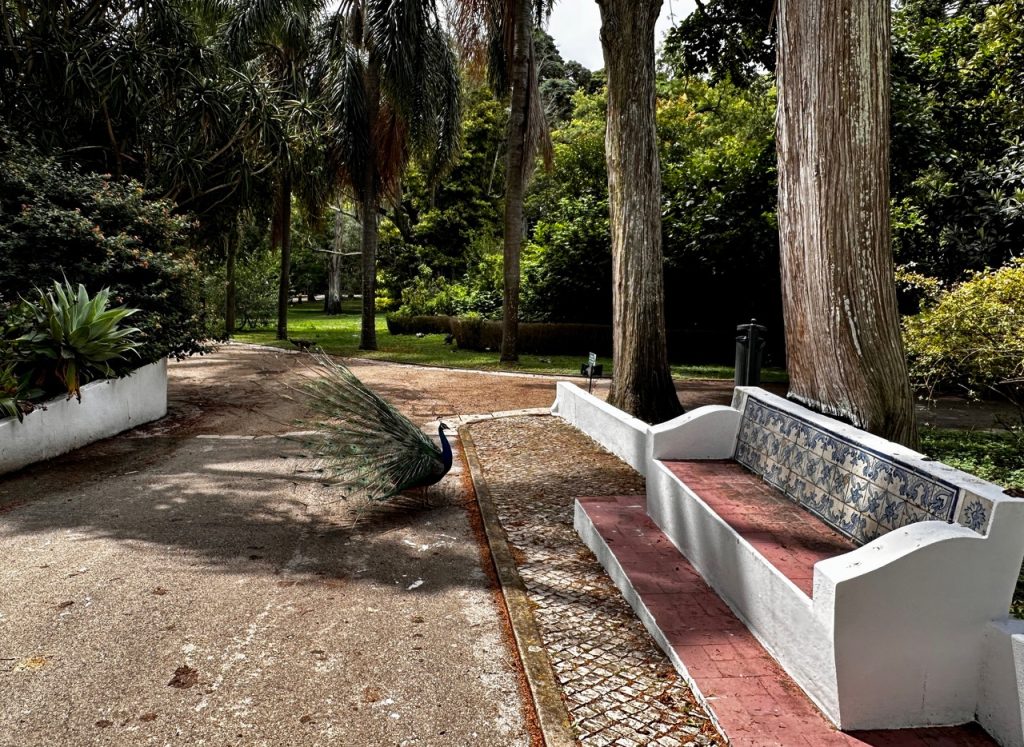
The main strip of Belem provides many options for a quick meal so you can get right to dessert. Pasteis de Belem connects visitors to the origin of the national specialty in 1837. In 1834, Portugal closed convents and monasteries, and those expelled from the monastery needed to raise money to survive. They started selling sweet pastries and we still enjoy them all over the country.
When I left the botanical garden, I delighted in discovering another sweet treat at Just Velvet on Rua dos Jeronimos. You can choose from red velvet cake, cupcakes, and brownies.

Sintra
A 45-minute train ride brings you to a treasure west of Lisbon, where you can find castles and entrancing gardens. Once you arrive at the Sintra station, options to reach the sights include a bus that makes multiple stops in a loop or a call for a ride-share with Bolt or Uber. At least once, splurge on a tuk-tuk to feel the wind in your hair as they whisk you to the next park.
The Pena Palace’s bright red and yellow walls wouldn’t look out of place in a Disney film. The intricate designs of the turrets, porticoes, and windows provide the perfect backdrop for selfies. Touring the palace rooms reveals elaborate tile patterns and elegant furniture. The Pena Palace is a very popular sight and can be very crowded. Buy tickets online and arrive early in the day, or book a tour.
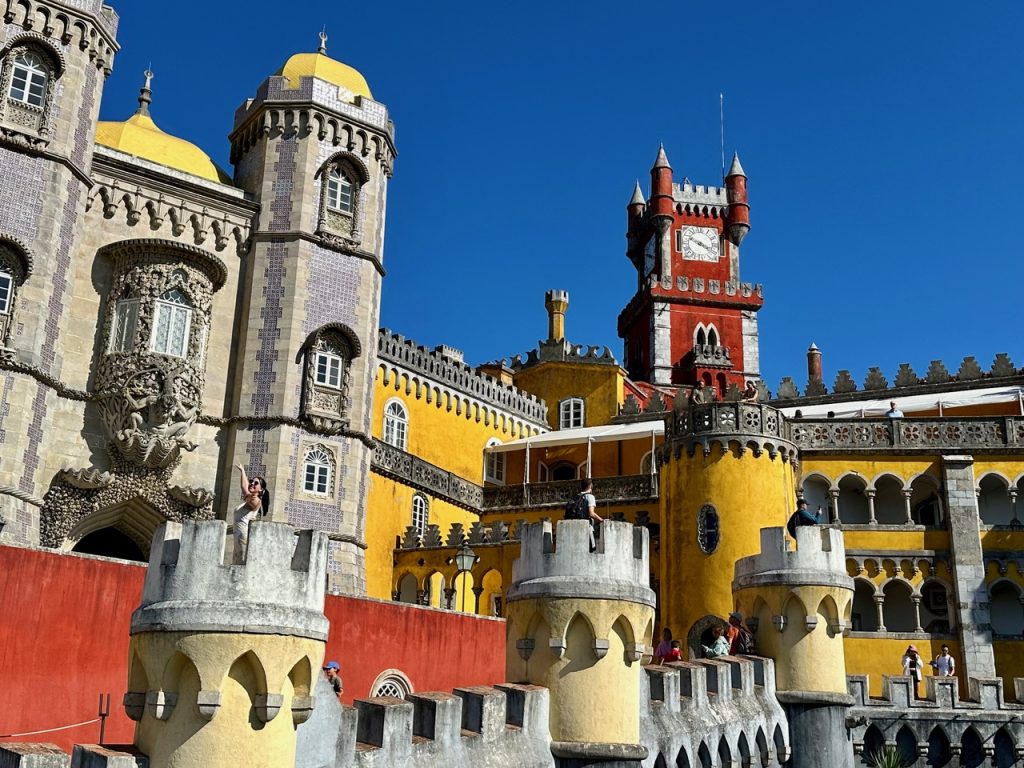
At the ruins of the Moorish Castle, you can climb stone steps up to an expansive view of the surrounding countryside. The steep steps can look daunting, but you will be rewarded if you take your time and reach the top.
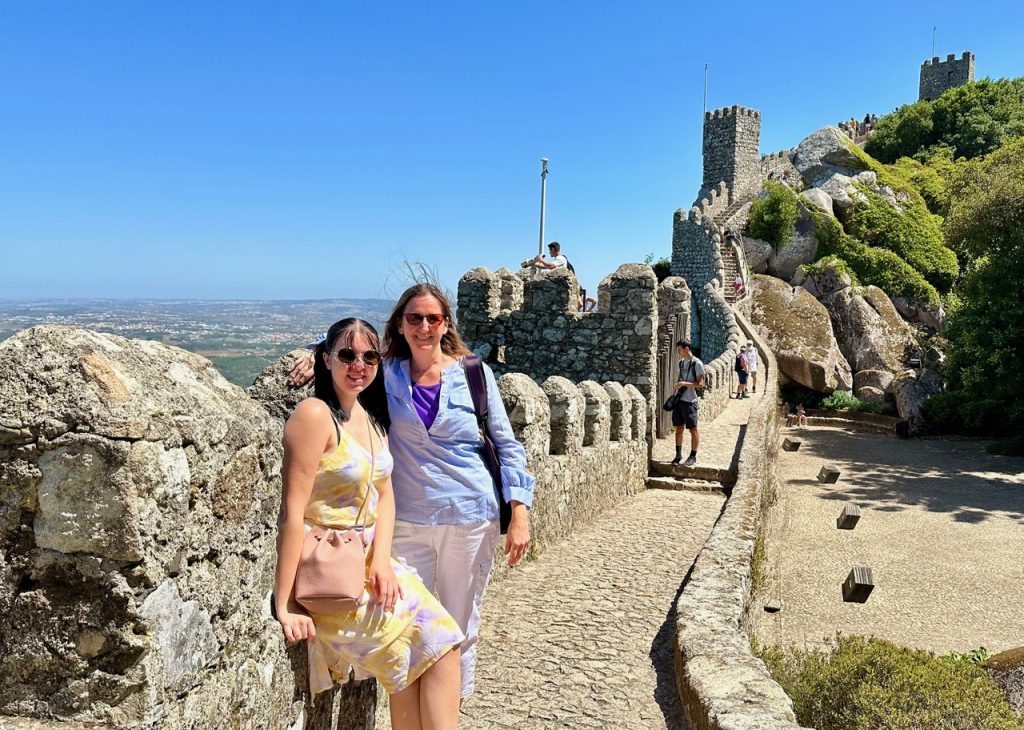
On my first trip to Sintra, I didn’t make it to Monserrate, so I started my second time there with a visit to this park. For over four hours, I explored every inch, marveling over each new type of garden into which the paths led me as well as the ornate palace. I ate a nice lunch at their café then called a ride-share to return me to the train station.
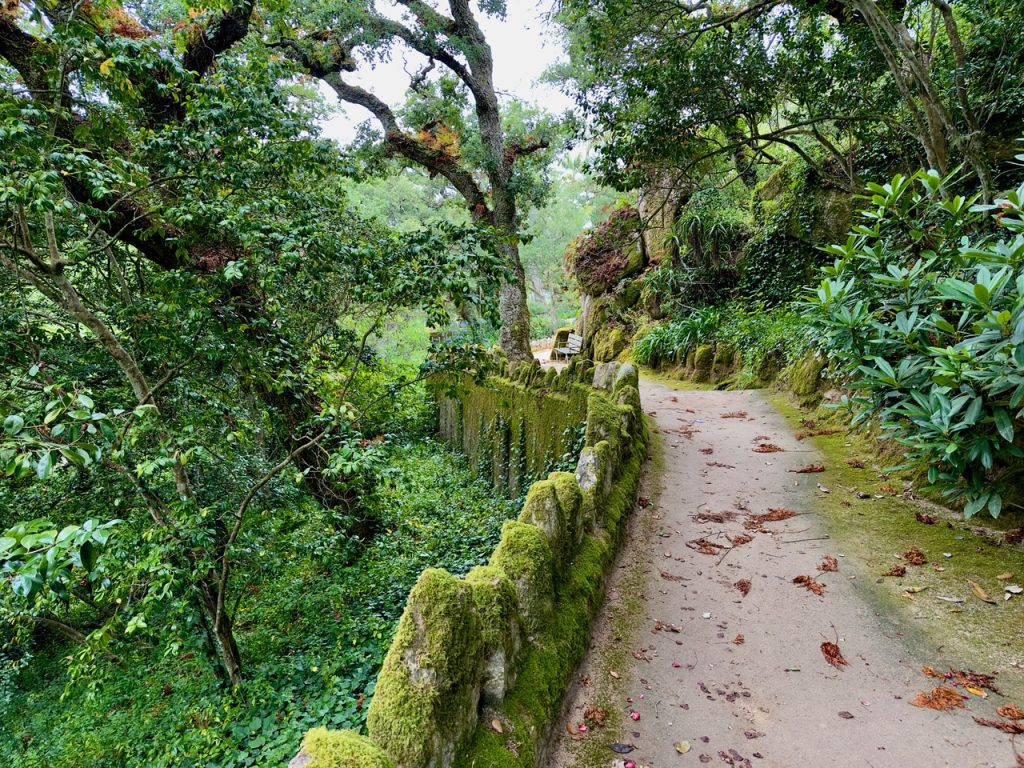
At Quinta da Regaleira, a large estate contains a small palace, ruins, fountains, caves, and hidden passageways. The features of the park reflect many architectural styles and elements. Every curve of the path brings you to something surprising and interesting. You can walk from the center of town in about a half hour.
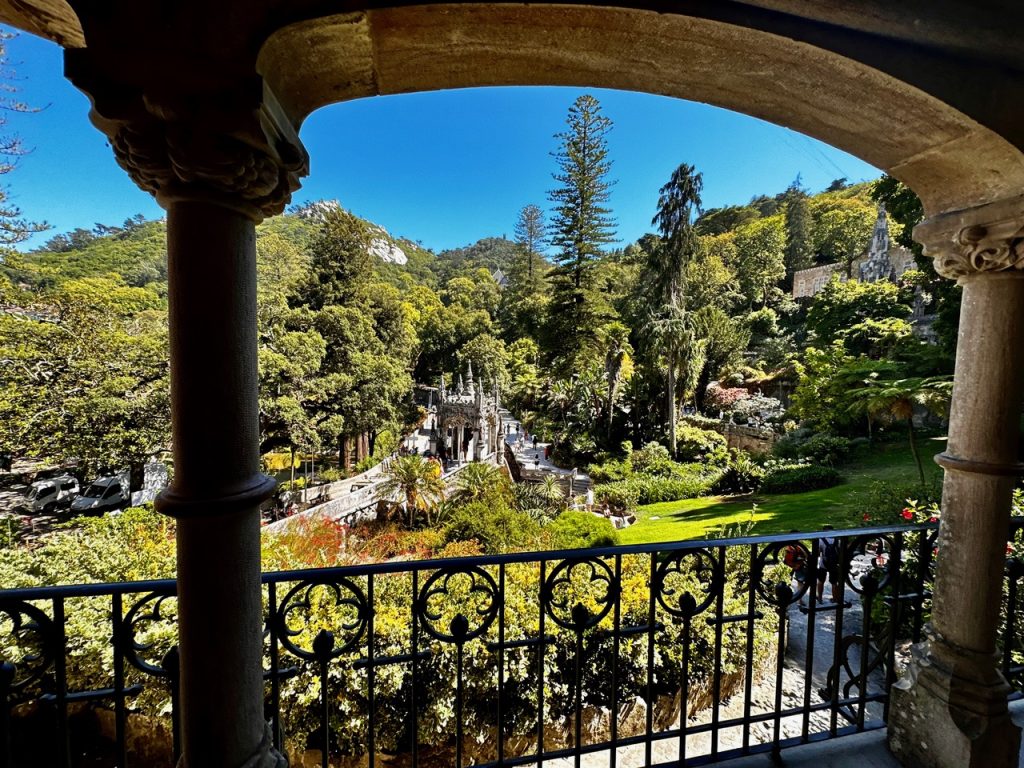
The National Palace of Sintra sits in the center of town and shows how the royal families lived from the 12th to 19th centuries. This palace was much less crowded so you can move through it leisurely, gazing at all the complex tile patterns and incredible ceilings.
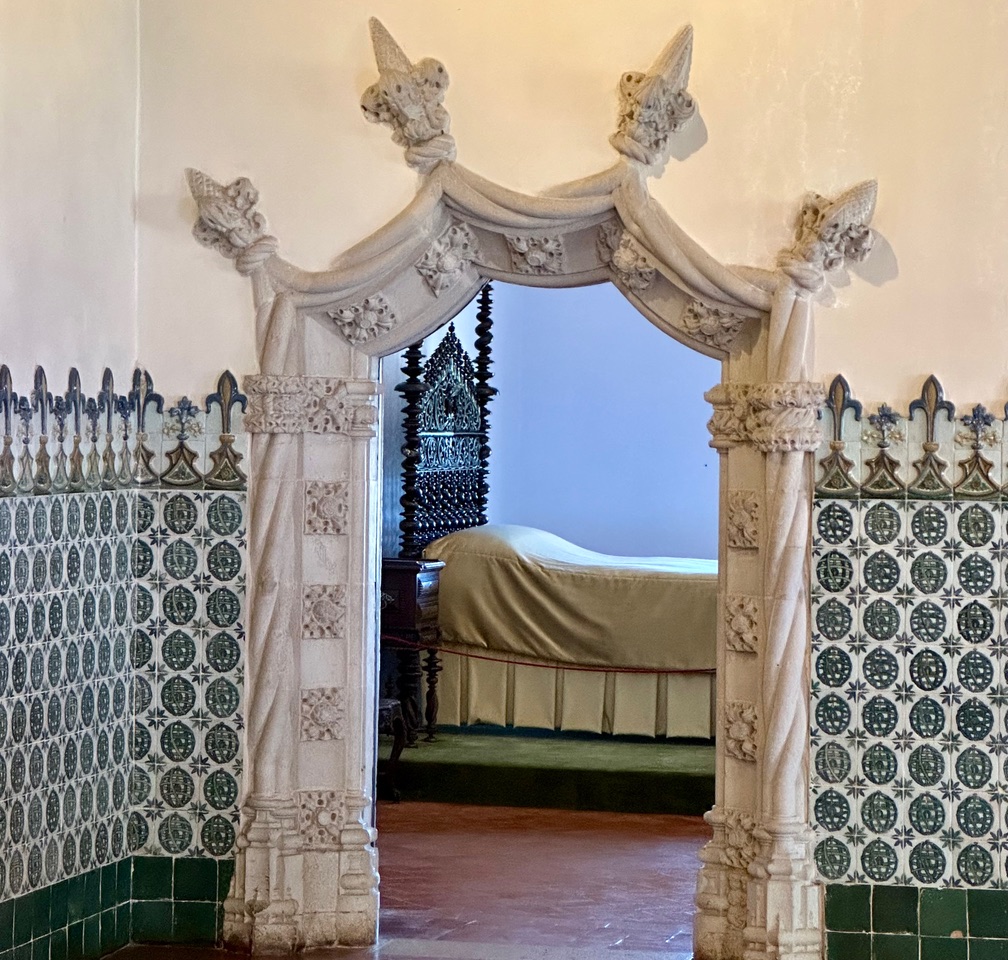
The center of Sintra, near the train station, offers many options for dining and shopping. Start the day with the Pena Palace, Monserrat, or the Moorish Castle, then head back to town to eat. In the afternoon, enjoy the Quinta da Regaleira and National Palace.
Places To Wander And Relax In Lisbon
My favorite activity in Lisbon is wandering the streets and hanging out in green areas and at viewpoints. Every neighborhood offers fabulous, tiled sidewalks and buildings, and open-air spots to drink and dine.
Miradouros (Viewpoints)
The hills of Lisbon may seem daunting at times, but without them, we couldn’t have the amazing views throughout the city.
From my favorite miradouro, Sao Pedro de Alcantara, the city stretches to the Castelo de Sao Jorge with the Tagus River shimmering on the right. A park with a fountain and benches offers shade and a kiosk for food and drinks. You can also take stairs down to another manicured area with seating and fabulous views. Musicians rotate to provide constant entertainment, and an artist sells simple scenes of the city for reasonable prices.
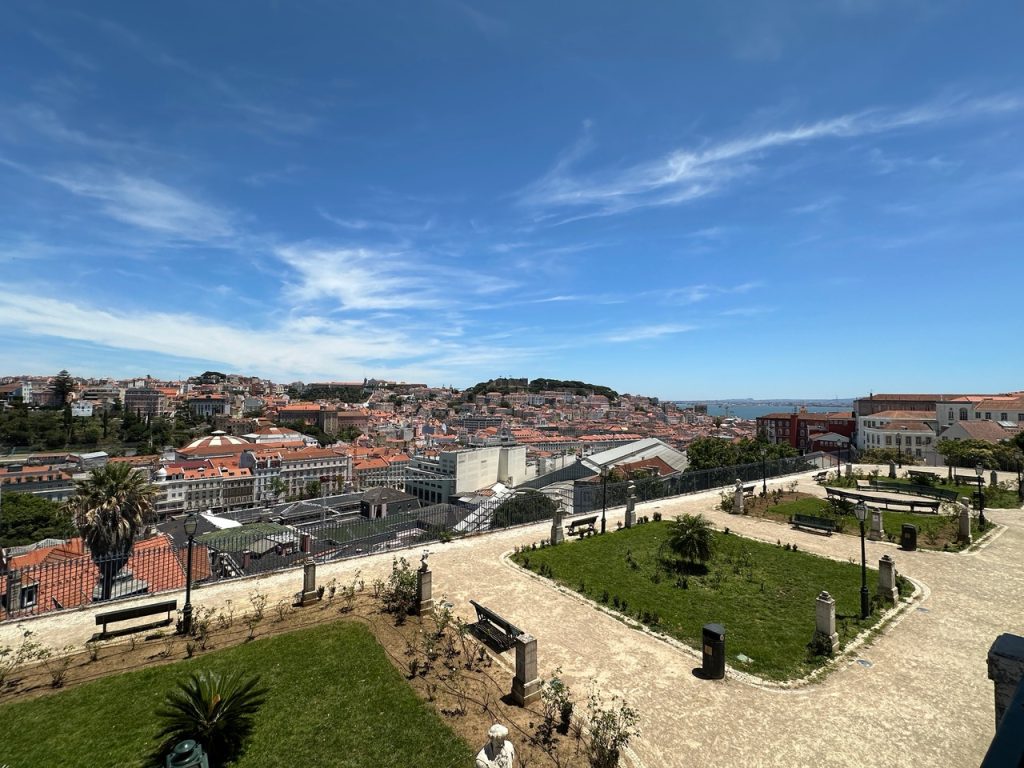
Miradouro das Portas do Sol, near the Cathedral, offers magnificent views of the river and has a small kiosk for pastries and drinks. Walk down the stairs by the church to reach Miradouro de Santa Luzia which has a lovely garden and tiled portico.
The highest viewpoint in Lisbon, Miradouro da Senhora de Monte, sits on the east side in the Moorish Quarter. If you want to feel like you conquered the hills of the city, walk up the stairs from Rua Damasceno Monteiro.
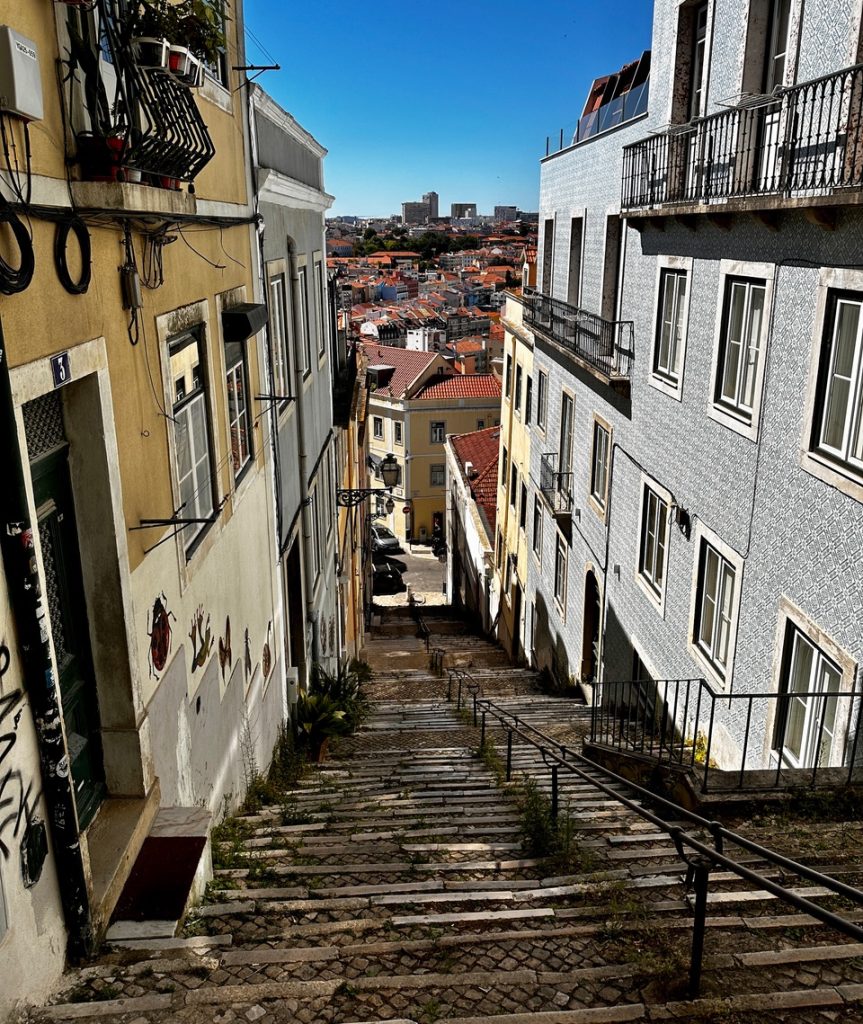
Pracas (Squares)
Although Lisbon is a dense city, it never feels overbearing due to the open squares throughout the streets. These areas showcase Calcada Portuguesa, the small black-and-white tiles hand-placed into elaborate designs. These tiles can be quite slick, especially if it is raining.
Restaurants often encircle and spill out onto the plazas. Vendors set up booths in many squares, and musicians provide a fun atmosphere.
The squares range in size from the enormous Praca do Comercio next to the Tagus River to small neighborhood nooks like Chiado Square which has a statue of a local poet.
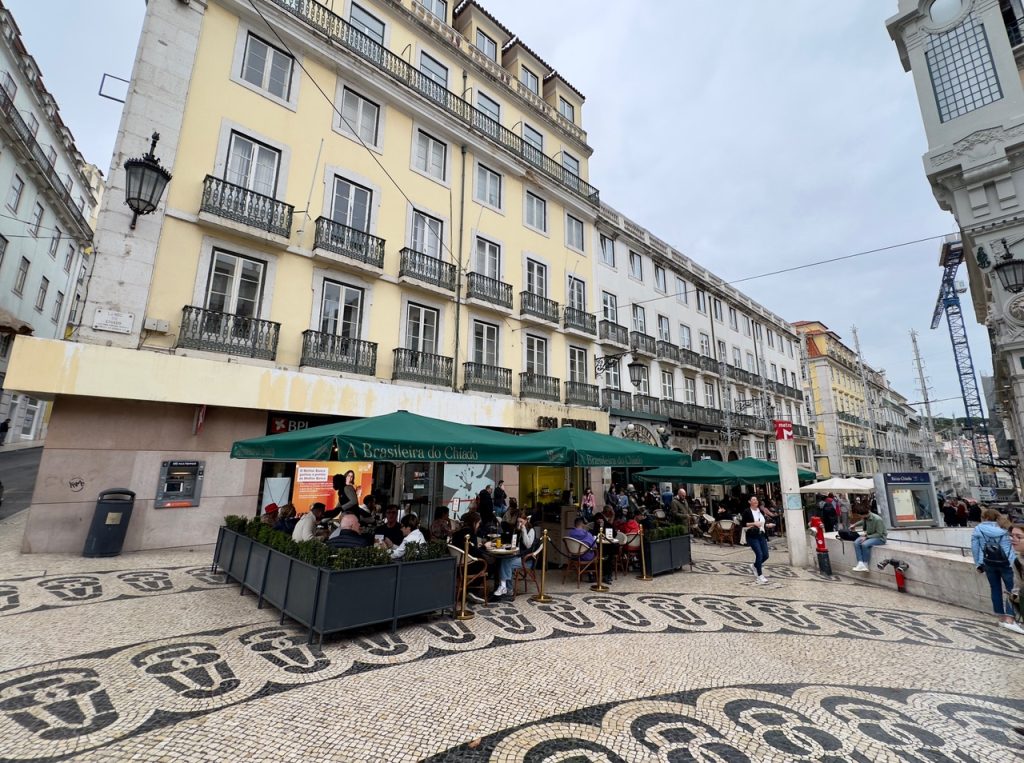
Parks
My favorite aspect of Lisbon is the many parks throughout the city. The Avenida da Liberdade stretches from Praca dos Restaudoures to Edward VII Park. Both sides of the boulevard contain water features, wide sidewalks tiled in various patterns, and acacia and plane trees that form a canopy and dapple the sunlight. Intermittent kiosks provide tables and chairs for a snack or drink and for listening to musicians.
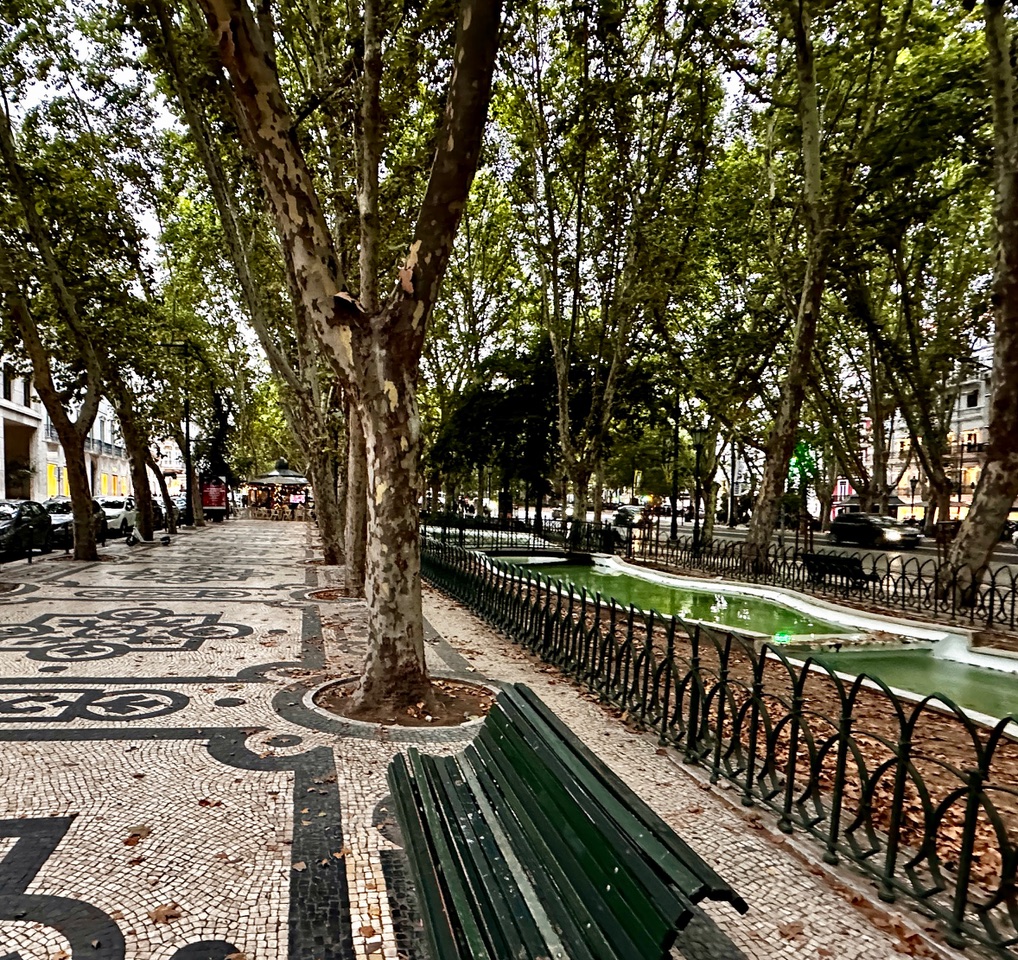
Small parks and squares with trees provide a respite while you wander the neighborhoods of Lisbon. Many of these also have kiosks and music. My favorites are the Jardim do Principe Real, Praca da Alegria, and Largo do Carmo. When you wander into one, take a break and find a seat to do some people-watching.
Botanical Garden of Lisbon
The Botanical Garden of Lisbon lies hidden in the Principe Real with an entrance off Rua da Escola Politecnica. Wandering through the intertwined paths, you see a wide variety of subtropical plants, including various palm trees and the high, spreading branches of the Monkey Puzzle tree. During my visits, there was constant construction noise from the surrounding neighborhoods. This wasn’t very pleasant but didn’t detract from the garden’s beauty.
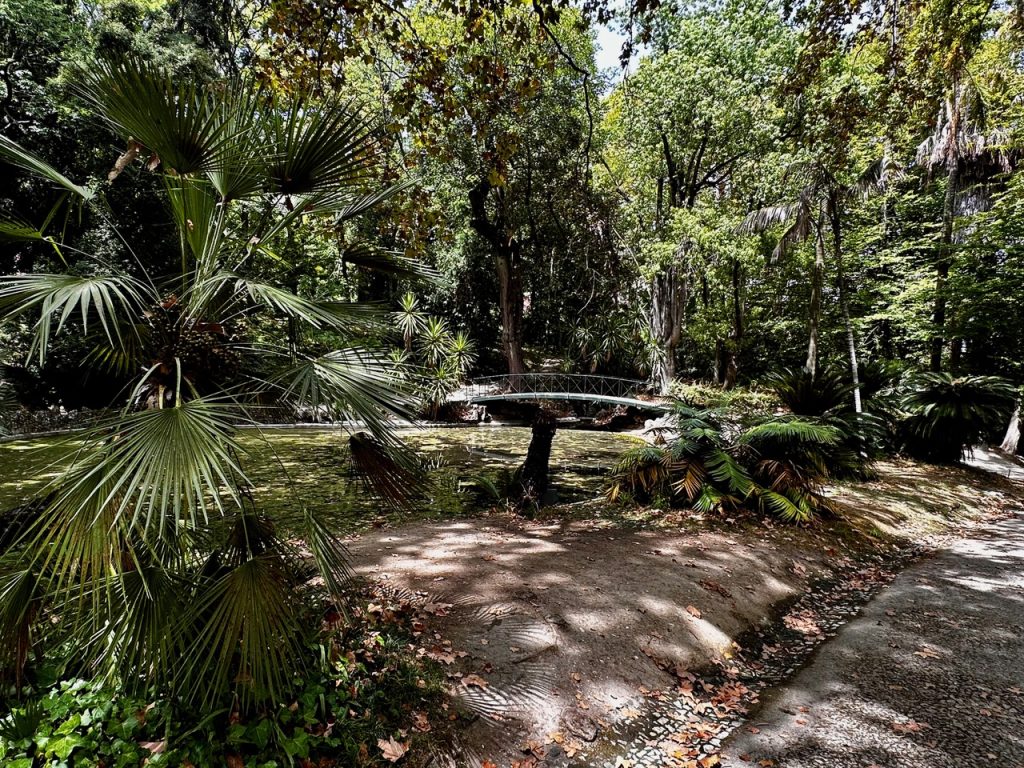
Tagus Riverfront
If you walk downhill from any part of Lisbon, you will end up at the Tagus Riverfront. You can ride the ferry across the river and back or take a tour boat. I prefer to sit on the low wall along the water and watch the people strolling by or playing at the small beach.
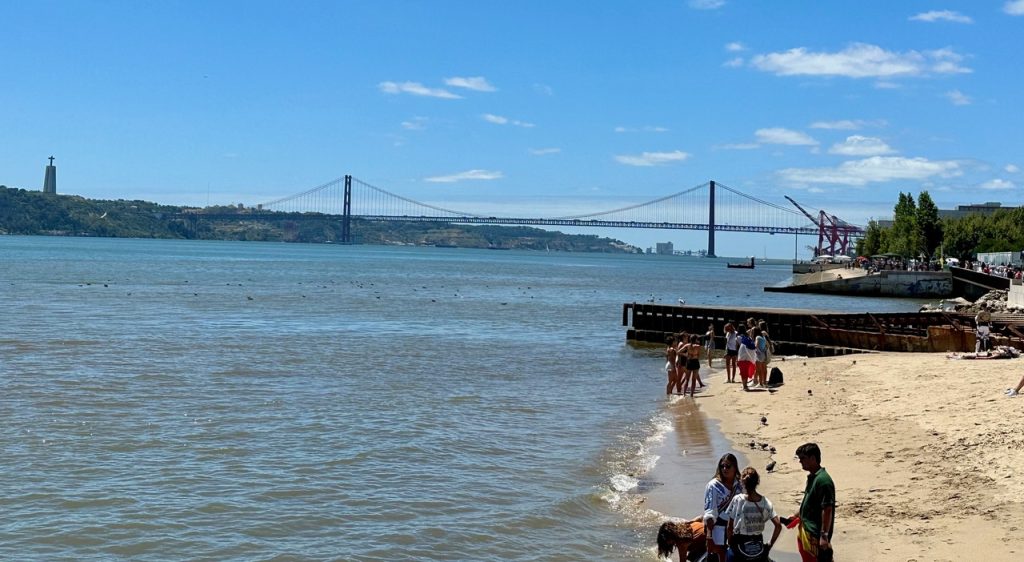
LX Factory
As a former industrial complex renovated into an entertainment district, LX Factory’s hip, vibrant vibe makes it a fun place to spend a day. I browsed booths selling clothes and accessories, explored the multilevel Ler Devagar, stuffed with books, and drank margaritas while listening to a band at Mex Factory. Pieces of artwork intersperse over 50 stores, restaurants, and bars. The complex is easily accessible by trains, ride-share, or even walking.
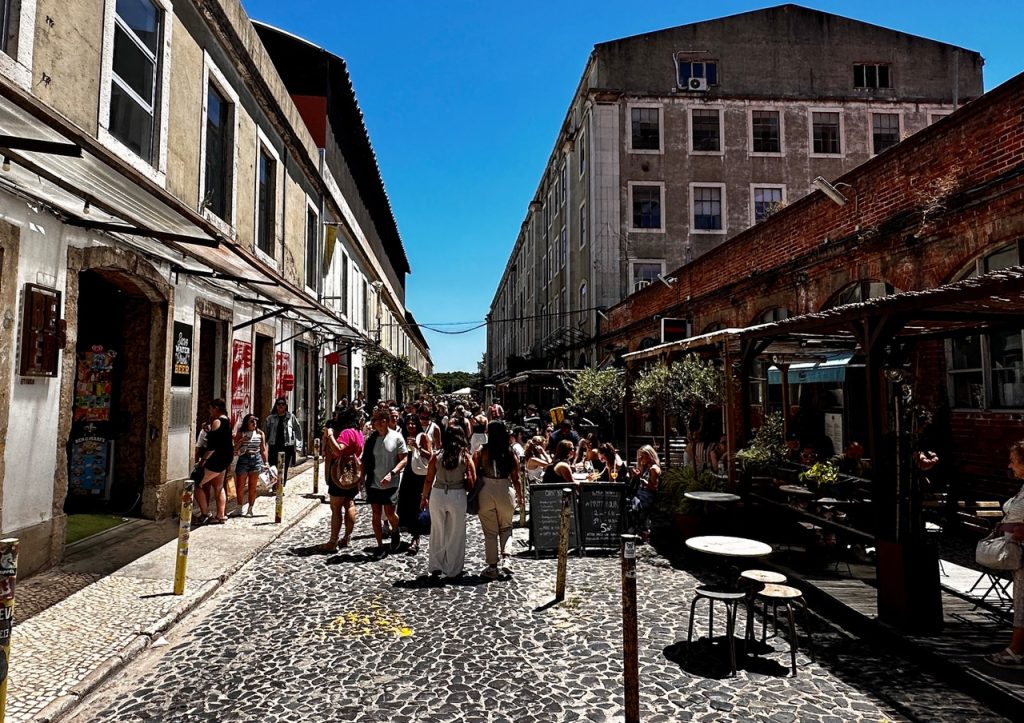
Neighborhoods In Lisbon To Explore and Stay During Solo Travel
Baixa
In the center of Lisbon, the Baixa neighborhood occupies a mainly flat area of streets laid out on a grid. It extends from the enormous Praca do Comercio next to the river to Avenue da Liberdade. The main street, Rua Augusta, is broad, with restaurant tables set up down the middle and many shops.
Staying in Baixa means being right in the middle of the city with easy access to all the sights and seeing many tourists. Since it is the low point of the city, if you are walking home at the end of a day, you have a downhill stroll.
Chiado
Chiado, the first neighborhood west of the Baixa, is also very central but has hilly streets. Cafes, theaters, and shops fill this area. I always stop at Livraria Bertrand, which claims to be the oldest continuously running bookstore in the world.
Staying in Chiado also means being right in the thick of tourists but with more of a unique Lisbon vibe.
Barrio Alto
Continue uphill to reach Barrio Alto, a lively part of the city with narrower streets. Many restaurants feature fado singers and outdoor patios fill the sidewalks. A couple of cheats to get up the hill are the escalator inside Rossio Station and the Gloria Funicular just past the station.
On one trip, I stayed in Barrio Alto, where people filled the restaurants and bars until late. I felt safe walking alone at night, but the streets were narrow and noisy, so others might not have felt as comfortable.
Alfama
Having escaped the destruction of the 1755 earthquake, Alfama is the oldest section of Lisbon. The narrow streets wind up and down hills and are fun to explore. This is a great place to indulge in fado music and ginja. The iconic berry-infused liquor can be found all over the city, but my favorite taste was a one-euro shot that I bought from two older Portuguese women set up in a doorway in Alfama.
Staying in Alfama puts you near the castle, cathedral, and flea market but makes exploring the rest of the city a bit more difficult.
Avenida da Liberdade
On my first visit to Lisbon, I rented an apartment one street from the Avenida da Liberdade. The wide, shaded sidewalks are still my favorite place to walk and hang out. Many tall hotels offer views of the city, and elegant shops offer upscale shopping.
This area costs a bit more for lodging, but reaching the sights without being thronged with tourists is not tricky. I have felt safe walking along the avenue as there is always foot and car traffic.
Principe Real
A little further uphill and to the west sits the Principe Real. My favorite parks are interspersed here, including the Praca da Alegria, Jardim do Principe Real, and the Botanical Garden. Rua Dom Pedro V offers many good, non-touristy restaurants.
Principe Real is my favorite place to stay, especially for visits longer than two or three days.
Getting Around Lisbon
Due to Lisbon’s compact layout and the many transportation options, there is no need to rent a car. Initially, it may seem a bit overwhelming, but after you hop on your first tram or change trains on the subway, you will quickly become a pro.
Walking
I can’t overstate how much I love the look of Lisbon’s streets, so I unless I am in a hurry or tired, I walk. Due to the city’s bowl shape and the grid layout, I find it difficult to get lost. Generally, if you know that you need to go up or downhill, it is easy to navigate.
Along the way, you are treated to the black-and-white mosaic of the sidewalks against the colorful tiles on most buildings. The sidewalks can be slick on steep hills, and I often walk next to the buildings and place a hand on the walls if needed.
Trams
The Lisbon trams provide a scenic ride through the city with large windows and routes that travel through the narrow streets. Once you learn how to use the trams, you can easily be whisked up any hill in your way.
You can pay on the tram, but buying a metro card at a subway station is easiest. Just jump aboard a tram and pass your card over the yellow box of the scanner. I like standing way in the back when climbing a hill and watching the street fall away as we move.
Tram 28 is often touted as a must-do for visitors to Lisbon as its route takes you around the city. I don’t find it worth waiting in line and crowding aboard. Many other routes will give you the tram experience and take you where you want to go.
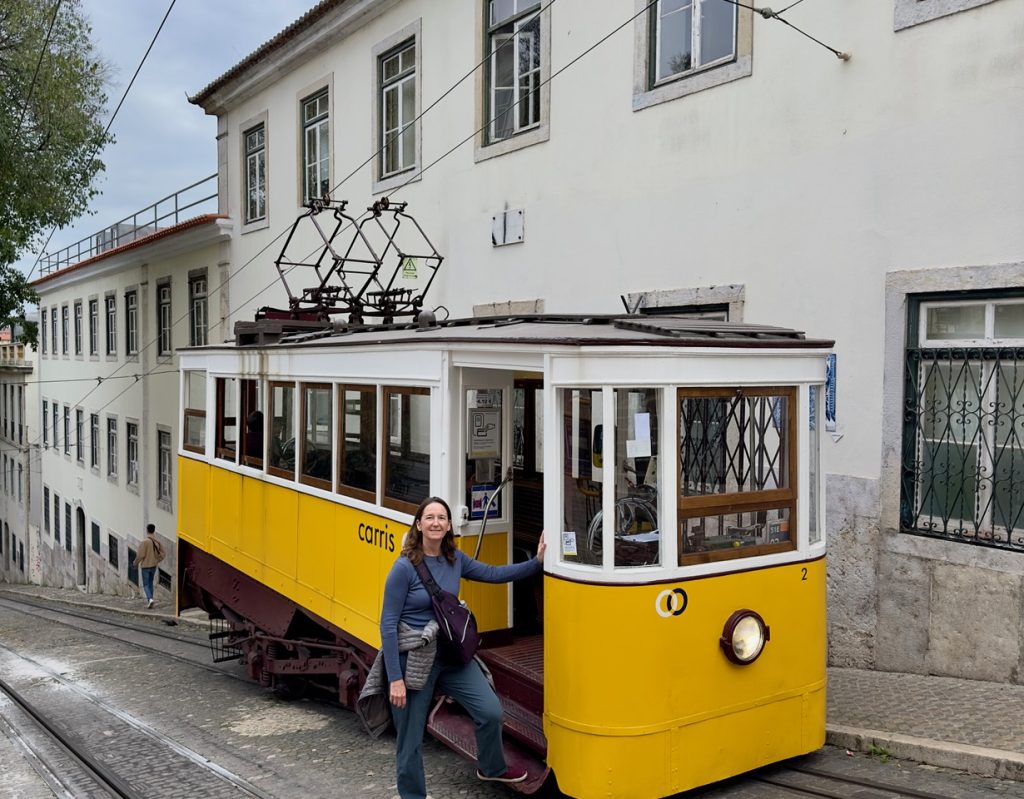
Subway
The Lisbon metro system includes four main lines, which are easy to navigate and safe. The subway is best when traveling long distances across the city. If you stay in Principe Real or along Avenida da Liberdade, the blue line brings you into the city’s center.
Regional Trains
The regional trains are a good option for spending a day in Belem or Sintra. You can tap your metro card when entering and exiting the platforms. Make sure you have enough money remaining on your card for the trip to be able to exit the station at the end of your ride.
I usually use Google Maps to find which train to take and how to get to the station. They typically stay on time but sometimes run behind. Check the monitor above the track to be sure it is the correct train. I once got on a train to Sintra and was surprised it left early. I realized it was the wrong train when it took a sidetrack. It was easy enough to jump off at the next station and ride a train back to my originally planned train.
Bus
The Lisbon bus system contains over 140 routes throughout the city and to the outskirts. Like the trams, you pass your metro card over the scanner as you board.
Ride Sharing App
I have never felt the need to rent a car in Lisbon because ride sharing apps are easy to use throughout the city. I usually check the Bolt and Uber apps to see which will be quicker and less expensive. Most rides within the city have cost me less than $10 and take me door to door. I use these mainly at night and have felt very safe with the drivers.
Iconic Food and Drink in Lisbon
As an international city, Lisbon offers a multitude of wonderful places to eat and drink. Most people rave about the seafood, but I don’t eat it anywhere, so I can’t comment on the quality here. I still find plenty of great options, from meat-based to vegetarian. Many writers or tour guides will warn you away from the tourist areas, but if I am hungry, I prefer to find something nearby or with a great view. The tourist areas also provide fun people-watching, and the food is generally good.
One specialty that cannot be missed is the pastel de nata. I am usually not a fan of custard, but you can’t beat these pastry cups fresh out of the oven. You can add some cinnamon and powdered sugar to make them even better. I had many good pasteis, but some of my favorite places to buy freshly made ones include Fabrica da Nata, Manteigaria, and Pasteis de Belem.
Another iconic treat in Lisbon is the cherry-infused liquor, Ginjinha or Ginja. I figured it would taste like cherry-flavored medicine, and I wouldn’t like it. However, I love the sweet and sour notes with a subtle cherry flavor and grab some for an afternoon or after-dinner treat.
Many tiny storefronts have a simple counter where you can buy a shot-sized Ginja. Also try the tiny chocolate cups filled with the liquor.
One other Portuguese specialty that I can’t resist on a warm, sunny day in Lisbon is Vinho Verde. This is often translated as green wine but refers to the Minho region in the northwestern part of the country where the grapes are grown. Vinho Verde is light and fruity with a little carbonation, making it a refreshing drink perfect for lunch or an afternoon treat.
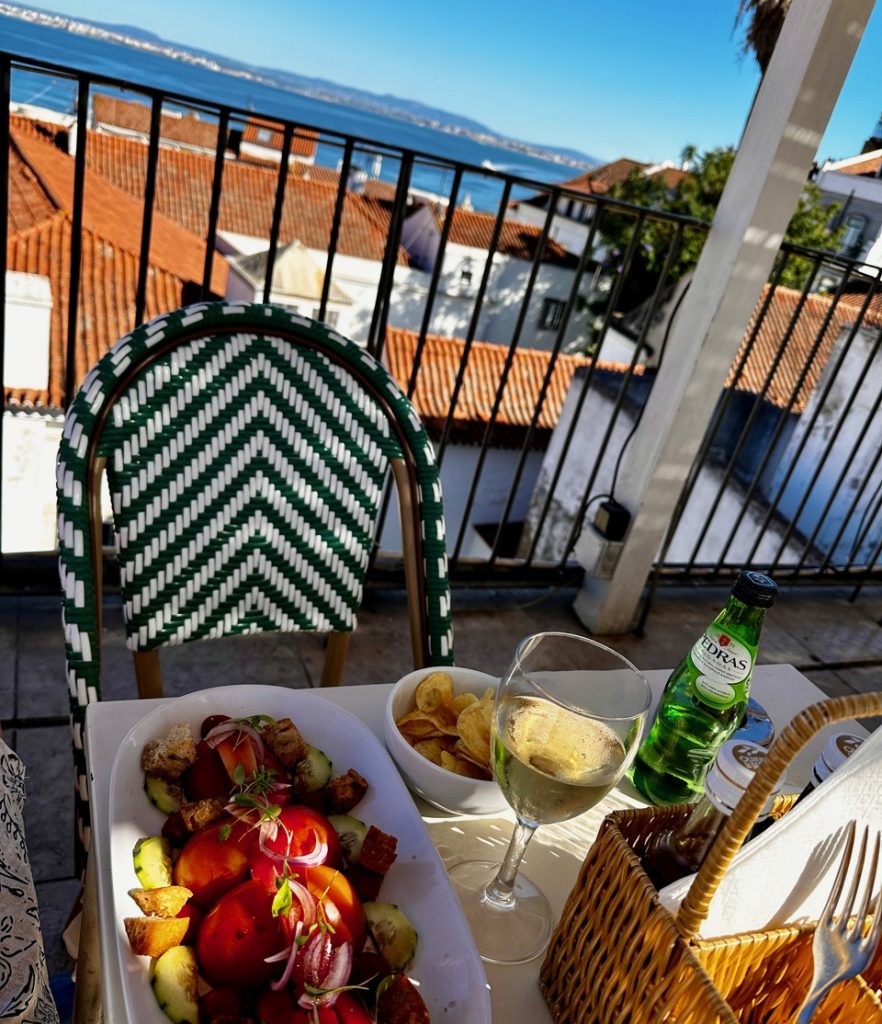
Safety in Lisbon for Solo Travel
Portugal is listed as one of the top ten safest countries in the world by the Global Peace Index. I have traveled there alone a few times, both in the cities and small towns, and have always felt safe.
Since Lisbon is a populous city, the usual precautions for visiting an urban area should be taken. Busy tourist spots can attract pickpockets and scammers, so keep your money protected and be aware of your surroundings. I generally carry the same purse or small bag and take the same precautions that I use at home in my city.
Abundant ATMs provide an easy way to get more euros, so you don’t need to procure large amounts of money for your trip. Most stores and restaurants accept credit cards, and I find that these give the best exchange rates.
I tend to get out early in the morning and turn in early after dinner. However, when I am walking alone after dark, I rarely feel unsafe, especially in areas where other people also walking. Most streets are well-lit. I will call a Bolt ride if I am at all worried. I have found public transportation to be busy at all times of the day without any disruptive passengers.
Portuguese Phrases
To be polite, I always try to know a few key phrases in the language of where I am traveling. Most people in Portugal speak English, but Portuguese is a beautiful language, and I encourage you to try learning it.
Here are a few words for you to use on your trip:
- Thank you = Obrigada/o (Oh bri ga’ da/doo) – if you are female, you say obrigada
- You’re welcome – typically, you just say Obrigada in return
- Hello = Ola (o la’)
- Good day/hello = Bom dia (Bone dee’ a) – bom has a nasal sound at the end
- See you soon = Ate logo (ah tay’ lo’ goo)
- Excuse me = Com licensa (cone lee sen’ sa) – for when you want to move past someone – asking permission
- Excuse me = Desculpe (de shkul’ pe) – moving past someone and asking forgiveness or I’m sorry
- Please = Se faz favor (suh fash fa vor’)
Meeting People in Lisbon for Solo Travelers
When doing solo travel in Lisbon, I have rarely felt lonely. Overall, people seem very friendly, and most speak English. I have had great interactions with waiters, shop owners, and those manning ticket offices at tourist sights.
I enjoy traveling alone and being in control of what I want to do and when. However, I have also found ways to get together with other travelers and residents for fun activities, and I have even made some enduring friendships.
Take a Class
Spending time in a classroom learning a new skill fosters building bonds with others from various walks of life. In 2024, I spent three weeks in Lisbon and studied Portuguese for two of those weeks. In the first week, my daily four-hour class consisted of seven people aged 17 to 67, and we all hailed from different countries. Four of us continued into the second week, and five more students joined us. Nothing is as bonding as struggling to learn a new language and laughing at our mistakes.
The school arranged an outing each week to show us a few interesting places in Lisbon and allow the students from different classes to mingle. I also met up with three students for a fun night at Defuse, a board game café where you can drop in, even alone, and pair up with others to play games.
Besides language classes, you can find cooking, art, or other classes taught by locals. This can also be a great way to get recommendations for what not to miss while in Lisbon. I try to time my visits in Lisbon to allow me to join a taiko drumming group. I have been playing taiko for ten years in Phoenix, so I love jumping in and trying to learn new songs. The group members have been extremely welcoming and excited when I return.
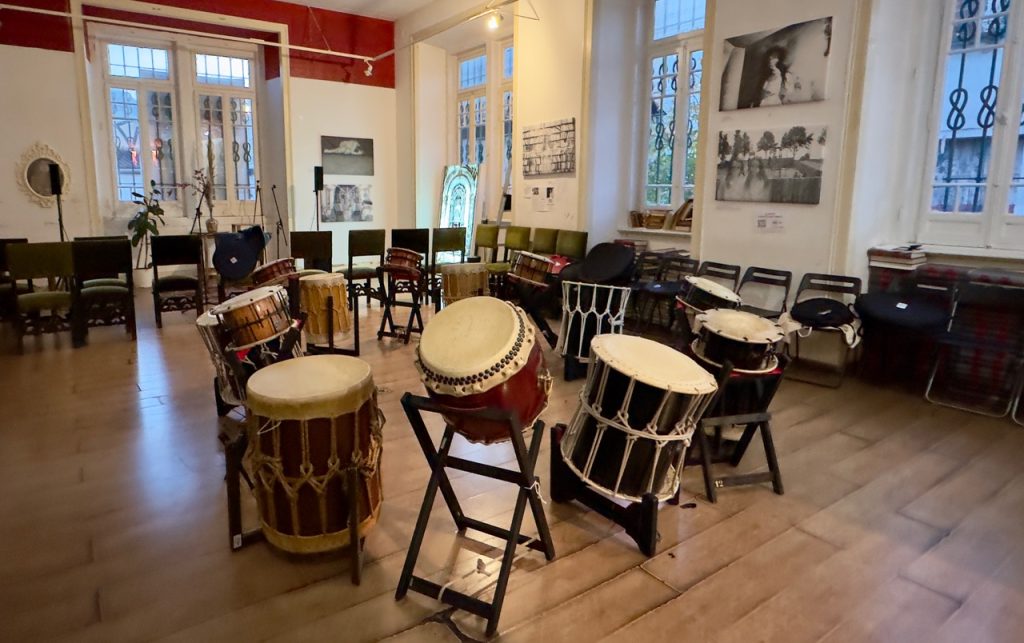
Sign Up for a Tour
You can also spend time with other travelers with similar interests by taking small group tours. I booked a tour through Get Your Guide for sightseeing and wine tasting in Arribida and Setubal, south of Lisbon. Four of the six women on the day tour were traveling alone, and we enjoyed chatting in the van and at lunch.
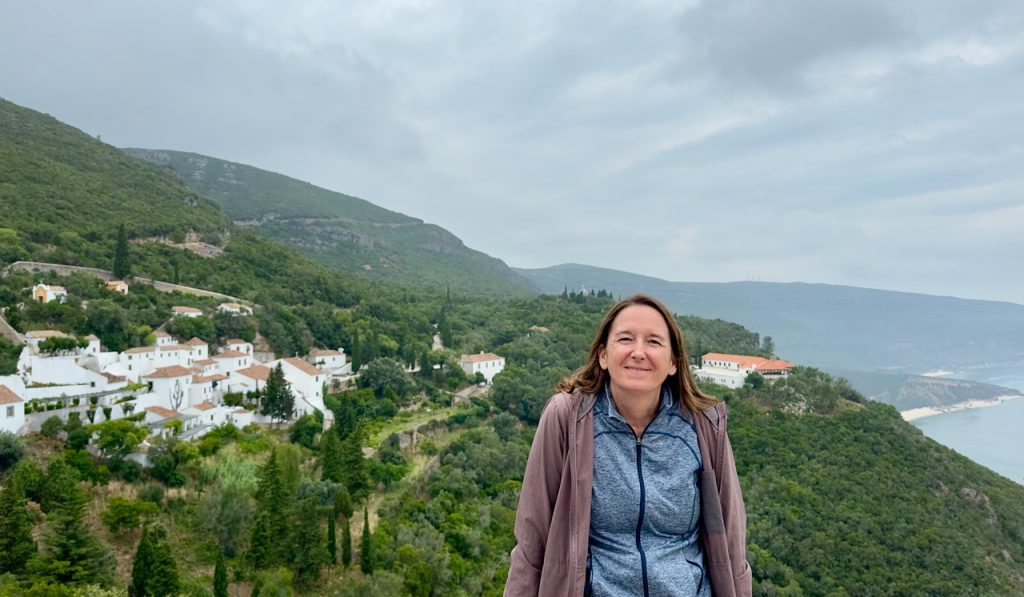
Another tour with World Experience, booked through The Tour Guy, included six other people for a land, sea, and sky view of Lisbon. We strolled through a few neighborhoods, learning about Portuguese history and culture. After a boat tour to Belem, we took turns flying in a small helicopter over the city.
Join Facebook Groups
Facebook groups can be another excellent way to meet people living in or visiting Lisbon. Search for groups of ex-pats, travelers, or a specific interest of yours and reach out to others about your travel plans.
My time in Lisbon overlapped with another Facebook group member’s trip by a week. We met up for lunch and then scheduled other activities once we discovered we got along well. On this same trip, I joined in on an ex-pat group’s Fourth of July picnic at a park.
Conclusion
I hope you enjoyed my ultimate guide for solo travel in Lisbon. The city offers so many opportunities for fun, engaging experiences through its museums, parks, restaurants, and neighborhoods. The beauty of the architecture and ease of moving around makes this a city worth visiting multiple times.
